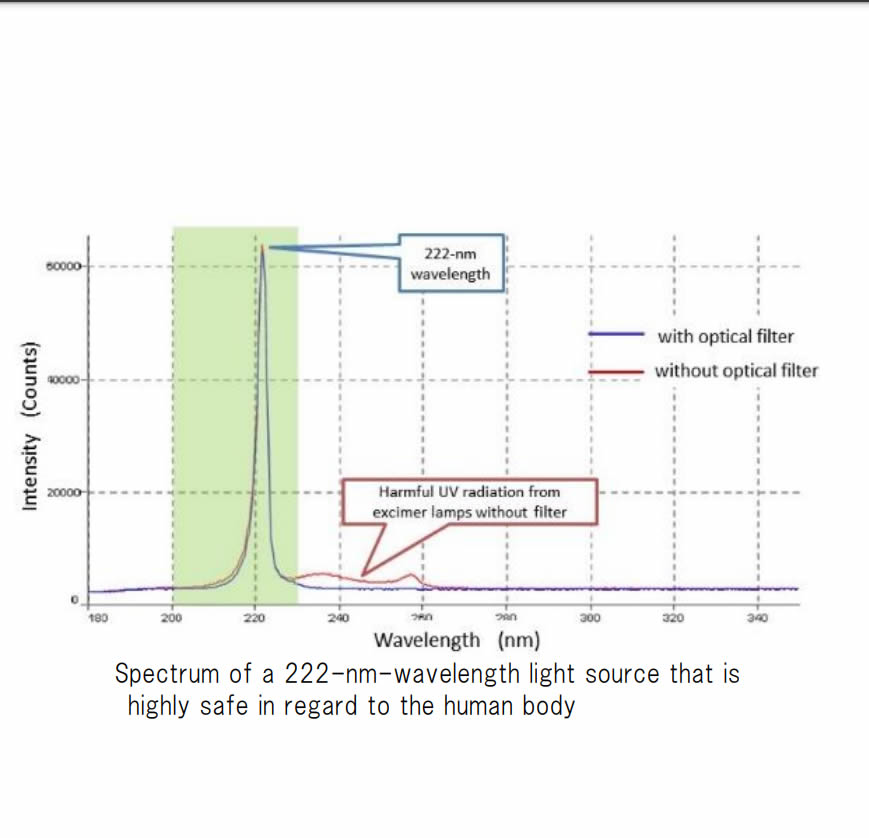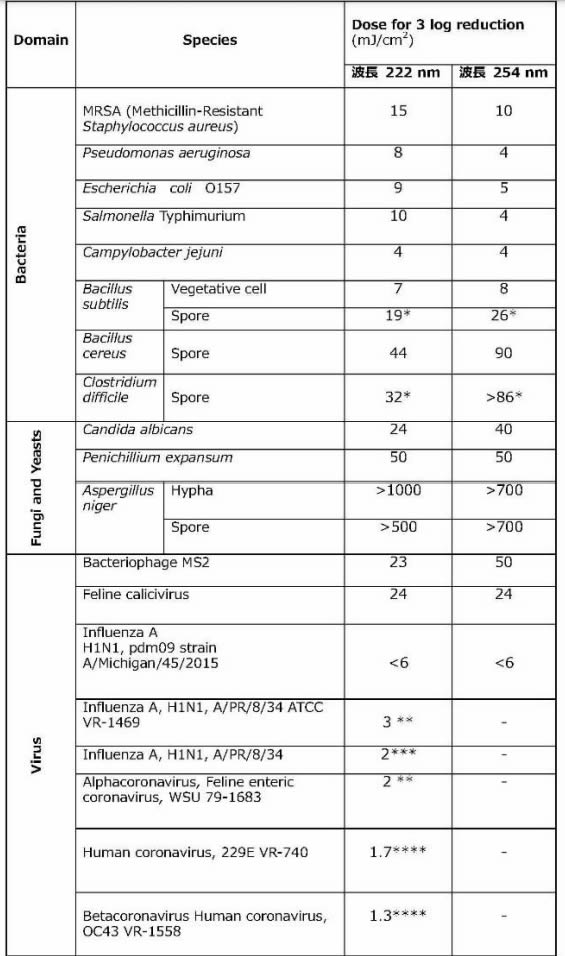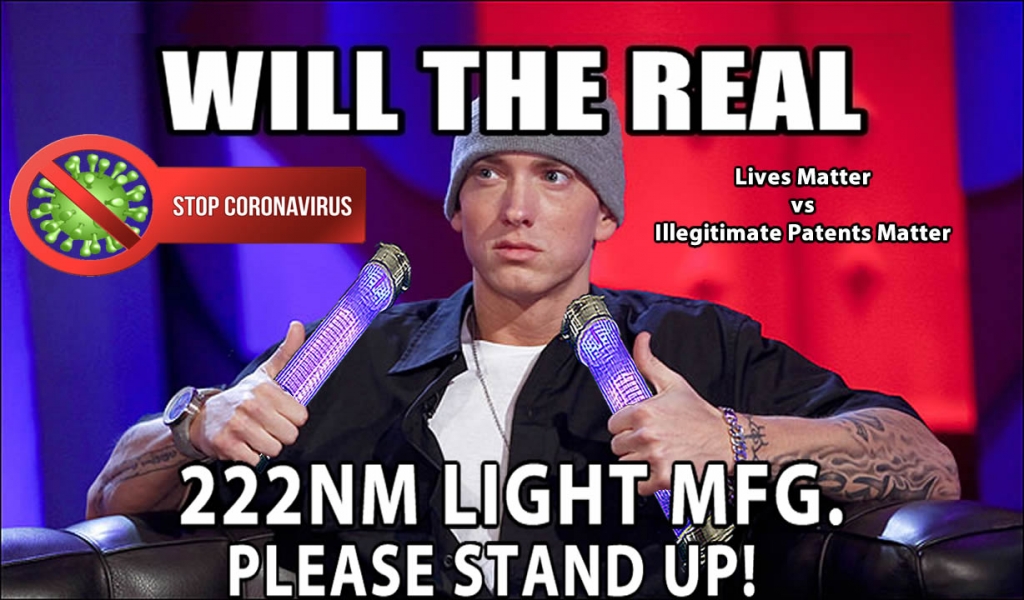In the press
In 1993 Ushio Electric commercialized the world’s first excimer lamp, today filtered Excimer Far-UVC 222-nm-wavelengths are regarded as very safe for the human body
State-of-the-art Technology: Inactivation of Pathogens using a 222-nm
Ultraviolet Light Source with an Optical Filter
Ushio Inc.
Hiroyuki Ohashi, Toru Koi, and Tatsushi Igarashi
Japan, South Korea, Taiwan, and USA Patents issued before 1-31-2005 Invalidates any US Patent Claim To 222nm Excimer Lamps!
Issued 1993 Ushio, Inc. Japan 222nm Excimer Prior Art: JP Patent Expired (end of life) 1-20-2013 https://patents.google.com/patent/JP2951139B2/en
Issued 1994 Ushio, Inc. South Korea 222nm Excimer Prior Art: US Patents Expired (fee-related) 9-20-1995 https://patents.google.com/patent/KR100212684B1/en
Issued 2001 Ushio Electric Inc. Taiwan 222nm Excimer Prior Art: US Patents Expired (fee-related) 10-22-2002 https://patents.google.com/patent/TW567307B/en
IntroductionUltraviolet (UV) radiation with a wavelength of 254 nm has been widely used for sterilization and inactivating viruses. UV radiation with a wavelength of 254 nm can effectively inactivate viruses and bacteria; however, irradiating the human body with such UV light can cause skin cancer and internal disorders. The use of UV irradiation at that wavelength in environments in which people are present has thus been avoided. Even so, UV radiation with a wavelength of 222 nm has recently been attracting attention because it has a strong effect in terms of sterilization and inactivating viruses in a similar manner to conventional 254-nm-wavelength UV radiation. As for safety, it has been confirmed by multiple medical institutions and universities that 222-nm UV is much safer than the conventional 254-nm UV radiation. If UV radiation were harmless to people, it could be used for sterilization and inactivating viruses in any public and commercial facilities in which people are socially active, such as hospitals, schools, and offices. It is therefore expected to balance the tradeoff between suppressing pandemics and maintaining social and economic activities.
A 222-nm-wavelength light source that is very safe in regard to the human body
Ushio Electric commercialized the world’s first excimer lamp in 1993, and the light source for UV radiation with a wavelength of 222 nm is a KrCl excimer lamp. Although the center wavelength of the KrCl excimer lamp is 222 nm, it also emits a small amount of light with other wavelengths. Basically, of the UV radiation on the short-wavelength side from the wavelength of 300 nm (which is not included in the solar radiation that reaches the ground), that with a wavelength of 230 to 300 nm is particularly harmful to the human body; accordingly, to be able to irradiate a space occupied by people, it is necessary to remove the UV radiation (so-called “harmful light”) in this long-wavelength region.
To meet that need, Professor David Brenner of Columbia University combined a KrCl excimer lamp with an optical bandpass filter to eliminate the long-wavelength UV radiation harmful to humans. He selected and successfully utilized only the UV with an inactivating effect on viruses and bacteria.
Ushio, Inc. acquired an exclusive worldwide license for a basic patent on this technology in 2015. We have consequently become the only company in the world capable of providing high-safety 222-nm wavelength excimer lamps.
Safety of 222-nm-wavelength UV Generally, UV radiation in the UV-B and UV-C regions damages DNA and RNA. When it irradiates the human body, it causes skin cancer, keratitis, and cataracts. On the contrary, UV radiation with a wavelength of 222 nm has been used in several animal experiments and human clinical trials. It has been reported that it is much safer than the conventionally used UV radiation with a wavelength of 254 nm. For example, according to a report published by Professor Kuroda’s group at Kobe University, healthy volunteers were tested to examine the safety of UV irradiation with a wavelength of 222 nm and its sterilization action on the skin. When the presence or absence of skin erythema (i.e., an acute injury due to UV radiation) was examined 24 hours after the end of irradiation (at a dose of 50-500 mJ/cm2 ), no erythema due to UV irradiation with a wavelength of 222 nm was observed in any subjects.
On the contrary, the minimum erythema dose due to UV irradiation with a wavelength of 254 nm is reported to be 10 mJ/cm2

The 222-nm-wavelength UV radiation did not damage the human body mainly because it has a shallow depth of penetration into the living body, and that reason was clarified by research by Professor Nishikori’s group at Kobe University
Usually, on the skin, conventional UV radiation reaches the bottom layer, namely, the basal layer of the skin’s epidermis, where it damages cells and DNA. In contrast, it was revealed that 222-nm-wavelength UV radiation only reaches the extreme outer layer of the stratum corneum, which is composed of dead cells,
so it hardly damages the DNA of epidermal cells. In addition to the above-described studies, Professor Tanito’s group at Shimane University reported a study on the safety of 222-nm-wavelength UV radiation concerning the eye)
The Spectrum of a 222-nm-wavelength light source that is highly safe regarding the human body evaluated acute corneal damage after 24 hours of UV irradiation in albino rats caused by UV radiation at wavelengths of 222 and 254 nm. The 254-nm-wavelength UV radiation developed superficial punctate keratitis at an exposure energy of 30–150 mJ/cm2, and corneal erosion was observed at 600 mJ/cm2. Moreover, hematoxylin and eosin staining indicated severe corneal epithelial defects in the eyes exposed to the 254-nm-wavelength UV radiation. On the contrary, as for the 222-nm wavelength UV radiation, no erosion was observed on the cornea even when exposure energy was 600 mJ/cm2. Long-term effects on living organisms have also been reported.
.
In the medical field, the human body may be irradiated directly and repeatedly, so the safety of 222-nm-wavelength UV radiation in terms of, for example, carcinogenicity must be verified. A group-A model mouse of xeroderma pigmentosum, which are very sensitive to UV radiation(namely, they are said to be about10,000 times more likely to develop skin cancer than wild-type mice), were repeatedly irradiated by 222-nm-wavelength UV radiation (2 ×100 mJ/cm2/week for 10 weeks followed by 15-weeks observation). When the safety of the UV irradiation regarding the skin and eyes was verified, it was found that the group mice irradiated by the 222-nm wavelength UV light did not develop skin cancer at all. In addition, no abnormalities were found in the eyes at the observation level with amicroscope3).About the sterilization and virus-inactivation effects of 222-nm-wavelength UV
Sterilization and virus-inactivating effect of 222-nm-wavelength UV light
A research group led by Professor Nakane of Hirosaki University has reported that similar to 254-nm-wavelength UV radiation, 222-nm-wavelength UV radiation inactivates a wide range of pathogens
As for spores, which are generally considered to be difficult to inactivate, it has been reported that 222-nm-wavelength UV radiation tends to be more effective than 254-nm-wavelength UV radiation

It has also been reported that 222-nm-wavelength UV radiation has a highly inactivating effect on human influenza and human coronavirus carried in aerosols
From that fact, it is considered that the novel coronavirus, which is suspected to be transmitted by an aerosol infection route, can also be inactivated by UV irradiation with a wavelength of 222 nm. The high safety level regarding the human body of UV irradiation with a wavelength of 222 nm and the inactivating effect on a wide range of bacteria and viruses indicate that this UV technology can be applied in various situations. We are looking forward to 222-nm-wavelength UV technology, which can inactivate viruses and bacteria without restricting people’s activities, contributing to meeting urgent social demands such as suppression of pandemics and avoidance of collapse of medical systems as well as maintenance of socio-economic activities.
17 Russian Patents issued before 1-31-2005 Invalidates US Patent Claim To 222nm Excimer Lighting!

